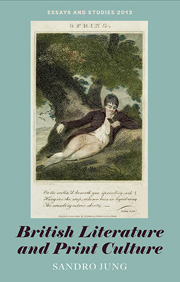Book contents
- Frontmatter
- Contents
- List of Illustrations
- Notes on Contributors
- Introduction
- Tracing a Genealogy of Oroonoko Editions
- The Pilgrim's Progress, Print Culture and the Dissenting Tradition
- Printing for the Author in the Long Eighteenth Century
- Robert Burn's Interleaved Scots Musical Museum: A Case-Study in the Vagaries of Editors and Owners
- Packaging, Design and Colour: From Fine-Printed to Small-Format Editions of Thomson's The Seasons, 1793–1802
- Print Illustrations and the Cultural Materialism of Scott's Waverley Novels
- Beyond Usefulness and Ephemerality: The Discursive Almanac, 1828–60
- The Last Years of a Victorian Monument: The Athenaeum after Maccoll
- Index
Beyond Usefulness and Ephemerality: The Discursive Almanac, 1828–60
Published online by Cambridge University Press: 05 October 2013
- Frontmatter
- Contents
- List of Illustrations
- Notes on Contributors
- Introduction
- Tracing a Genealogy of Oroonoko Editions
- The Pilgrim's Progress, Print Culture and the Dissenting Tradition
- Printing for the Author in the Long Eighteenth Century
- Robert Burn's Interleaved Scots Musical Museum: A Case-Study in the Vagaries of Editors and Owners
- Packaging, Design and Colour: From Fine-Printed to Small-Format Editions of Thomson's The Seasons, 1793–1802
- Print Illustrations and the Cultural Materialism of Scott's Waverley Novels
- Beyond Usefulness and Ephemerality: The Discursive Almanac, 1828–60
- The Last Years of a Victorian Monument: The Athenaeum after Maccoll
- Index
Summary
The Early Nineteenth-Century Almanac
The presence of the almanac in eighteenth- and nineteenth-century households from right across the social scale has long been noted by historians of print culture. Characterised as publications within the important category of ‘pocket usefulness’ by James Raven, almanacs were a vital source of information within an agricultural society. If the almanac was not always to be found in the pocket, then it may have moved no further than the table – ‘Of all books the Almanack is the most indispensable. So constant is the need for it that, unlike other books, it is not deposited on the shelf, but lies ready to hand on the table.’ As William St. Clair elaborates:
Almanacs gave the dates of the monthly and annual fairs held in the larger towns, essential information for an agricultural economy. They gave much information about the tides on which all sea-borne and much river-borne trade depended. They set out the dates of church festivals, used to recommend the best times for crop planting and harvesting, as well as for the renewals of labour contracts, the collection of tithes, taxes and rents, and for scheduling religious festivals. They also set out the dates of law and university terms.
- Type
- Chapter
- Information
- British Literature and Print Culture , pp. 158 - 194Publisher: Boydell & BrewerPrint publication year: 2013

